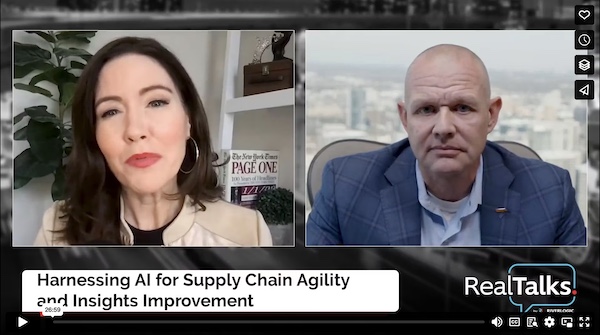Author Carlos Centurion
In the dynamic landscape of modern business, integrating artificial intelligence (AI) into supply chain strategy has become imperative for sustained success. Recently, I had the privilege of participating in a Real Talk webinar with Accenture, where we delved into AI’s transformative potential in supply chain strategy. Drawing upon my experience as President of River Logic alongside Pierre Mawet, Managing Director at Accenture’s North America supply chain practice, I am excited to share the key insights from our engaging discussion.
Realizing AI’s Value in Supply Chain Strategy
AI is a catalyst for revolutionizing supply chain strategies, promising enhanced agility and operational insights. While its initial value has been evident in productivity improvements and support for sourcing and procurement processes, its true transformative potential lies in optimizing operations, providing insights for strategic decisions, and driving tangible business outcomes.
Specific Use Cases and Strategic Objectives
During the webinar, we explored distinct use cases where AI integration delivers measurable value to organizations. Two prominent areas include network design and risk mitigation, where AI-powered optimization models refine data quality and interpretation, thus facilitating optimal decision-making.
Regarding Network Design, where the objective has always been and is to improve service levels, reduce cost, and improve profitability, there’s much initiative around using AI in conjunction with optimization models to improve the quality of the data that goes into scenarios as well as to interpret scenarios that lead to better decisions around manufacturing footprint for distribution, flow path, etc.
When it comes to risk mitigation, or what some people call business continuity planning, the objective is to use various scenarios to understand what could and might happen to come up with optimal answers. By leveraging vast amounts of external data sources, AI enriches internal data and empowers more informed decision-making.
Learn more about Business Continuity Planning In Supply Chain: Lessons From Mike Tyson
Addressing Challenges and Mitigating Risks
Despite its potential, implementing AI in supply chain strategy presents challenges such as data quality and the risk of AI “hallucination.” Strategic partnerships and rigorous validation processes are essential in overcoming these hurdles and realizing AI’s full potential.
Who is leading the change within the organizations?
Typically, we see a digital excellence or transformation team in charge of automation, digitalization, and innovation. This team owns the budget and the mandate to test out new technologies and has a vast interest in AI. But in order to identify the truly transformative, high value areas to apply AI, they must partner with the business. We often see digital innovation teams partner around specific use cases with the leads at supply chain, network planning, Long-range planning, and supply chain strategy teams. Here is where the real transformation happens.
Looking Ahead: River Logic’s AI Roadmap
Exciting developments are underway at River Logic, with AI capabilities integrated into our Value Chain Optimization solution. Prototypes are already underway, aiming to enhance user experience and decision-making processes. A forthcoming webinar led by River Logic’s Chief Technology Officer will provide deeper insights into these innovations, offering a glimpse into the future of AI-powered supply chain strategy.
Register Here: Empowering Supply Chain Practitioners: AI—Powered Innovations by River Logic
Here at River Logic, our vision is to help people start adopting AI. Right now, we can see two horizons for the use of AI. Horizon One is improving the overall user experience, allowing the user to work faster. However, it does not necessarily alter the fundamentals of how you do planning and network optimization. One example of this is filling in data gaps. It can help analyze not only historical but also current events. Not only create that data but then look across the data set and run validations. That’s tremendously helpful for users. And the evolution of that will be to be even more proactive and suggest what scenarios to run.
The second bucket is more visionary. It basically says to the AI, now that you’re seeing the evolution of the business, where would you adjust the Algorithms in the underlying representation of the business for better findings and optimal decision-making?
At River Logic, we have already got the integration working with Microsoft Open AI to make this a reality, there is a prototype, and we’ve been working with this team, focusing initially on Horizon 1: improving the user experience with AI.
Advice for Leaders Embarking on the Journey
Embracing AI requires navigating the hype and carefully selecting use cases, partners, and software providers. Testing, learning, and adjusting strategies are essential steps in realizing AI’s transformative potential while managing expectations and ensuring resource alignment.
Conclusion
The AI revolution in supply chain strategy holds tremendous promise for organizations seeking to enhance agility, resilience, and competitiveness. By leveraging AI strategically, businesses can navigate complexity, drive operational excellence, and discover new avenues of growth in an increasingly dynamic marketplace.
Click on the video below to watch the full webinar recording.




